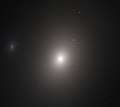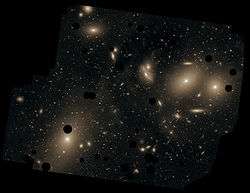Messier 86
Messier 86 (also known as M86 or NGC 4406) is an elliptical or lenticular galaxy in the constellation Virgo. It was discovered by Charles Messier in 1781. M86 lies in the heart of the Virgo Cluster of galaxies and forms a most conspicuous group with another large galaxy known as Messier 84. It displays the highest blue shift of all Messier objects, as it is approaching the Milky Way at 244 km/s. This is due to its falling towards the center of the Virgo cluster from the opposite side, which causes it to move in the direction of the Milky Way.[3]
| Messier 86 | |
|---|---|
 M86 by Hubble Space Telescope | |
| Observation data (J2000 epoch) | |
| Constellation | Virgo |
| Right ascension | 12h 26m 11.7s[1] |
| Declination | +12° 56′ 46″[1] |
| Redshift | -0.000814 ± 0.000017 (-244 ± 5 km/s)[1] |
| Distance | 52 ± 3 Mly (15.9 ± 1.0 Mpc)[2] |
| Apparent magnitude (V) | 9.83[1] |
| Characteristics | |
| Type | S0(3)/E3[1] |
| Apparent size (V) | 8′.9 × 5′.8[1] |
| Notable features | displays a rare blue shift |
| Other designations | |
| NGC 4406,[1] UGC 7532,[1] PGC 40653,[1] VCC 0881[1] | |
Messier 86 is linked by several filaments of ionized gas to the severely disrupted spiral galaxy NGC 4438 and shows some gas and interstellar dust that may have been stripped of it like the one present in those filaments.[4] It is also suffering ram-pressure stripping as it moves at high speed through Virgo's intracluster medium, losing its interstellar medium and leaving behind a very long trail of X ray-emitting hot gas that has been detected with the help of the Chandra space telescope.[5]
Messier 86 has a rich system of globular clusters, with a total number of around 3,800.[6] Its halo also has a number of stellar streams interpreted as remnants of dwarf galaxies that have been disrupted and absorbed by this galaxy.[7]
Gallery

 The Virgo Cluster of galaxies (Burrell Schmidt telescope)
The Virgo Cluster of galaxies (Burrell Schmidt telescope)
See also
References
- "NASA/IPAC Extragalactic Database". Results for NGC 4406. Retrieved 2006-11-14.
- Jensen, Joseph B.; Tonry, John L.; Barris, Brian J.; Thompson, Rodger I.; et al. (2003). "Measuring Distances and Probing the Unresolved Stellar Populations of Galaxies Using Infrared Surface Brightness Fluctuations". Astrophysical Journal. 583 (2): 712–726. arXiv:astro-ph/0210129. Bibcode:2003ApJ...583..712J. doi:10.1086/345430.
- Jacoby, G. H.; Kenney, G. H.; Tal, J. D. P.; Crowl, H. H.; et al. (2005). "Imaging and Spectroscopy of Large Scale H-alpha Filaments in M86". Bulletin of the American Astronomical Society. 37: 1392. Bibcode:2005AAS...20713806J.
- Gomez, H. L.; Baes, M.; Cortese, L.; Smith, M. W. L.; Boselli, A.; Ciesla, L.; et al. (2010). "A Spectacular Hα Complex in Virgo: Evidence for a Collision between M86 and NGC 4438 and Implications for the Collisional ISM Heating of Ellipticals". Astronomy and Astrophysics. 518: L45. arXiv:1005.1597. Bibcode:2010A&A...518L..45G. doi:10.1051/0004-6361/201014530. L45.
- Randall, S.; Nulsen, P.; Forman, W. R.; Jones, C.; Machacek, M.; Murray, S. S.; et al. (2008). "Chandra's View of the Ram Pressure Stripped Galaxy M86". The Astrophysical Journal. 518 (1): 208–223. arXiv:0806.0866. Bibcode:2008ApJ...688..208R. doi:10.1086/592324.
- "Globular Cluster Systems in Galaxies Beyond the Local Group". NASA-IPAC Extragalactic Database (NED). Retrieved 2012-07-21.
- Janowiecki, Steven; Mihos, J. Christopher; Harding, Paul; Feldmeier, John J.; et al. (2010). "Diffuse Tidal Structures in the Halos of Virgo Ellipticals". The Astrophysical Journal. 715 (2): 972–985. arXiv:1004.1473. Bibcode:2010ApJ...715..972J. doi:10.1088/0004-637X/715/2/972.
- "Beacon of Light". www.spacetelescope.org. Retrieved 23 September 2019.
External links
| Wikimedia Commons has media related to Messier 86. |
- SEDS Lenticular Galaxy M86
- Messier 86 on WikiSky: DSS2, SDSS, GALEX, IRAS, Hydrogen α, X-Ray, Astrophoto, Sky Map, Articles and images
